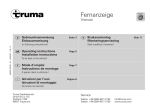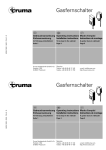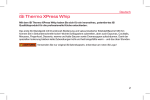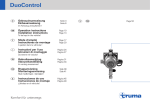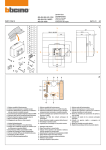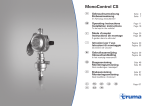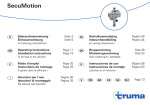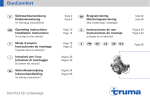Download Duomatic L
Transcript
Duomatic L 50020 - 35300 · 02/98 · 5’B+W · © Gebrauchsanweisung Operating instructions Mode d’emploi Installation instructions Instructions de montage Einbauanweisung Im Fahrzeug mitzuführen! To be kept in the vehicle! À garder dans le véhicule! Seite 1 Page 3 Page 5 Service Truma, Postfach 1252 D-85637 Putzbrunn Telefon D-(0) 89/4617-142 Telefax D-(0) 89/4617-159 Duomatic L A 4 3 1 3 5 B 6 7 10 8 9 11 2 50 cm Duomatic L Regler-Umschaltautomatik für die Zweiflaschen-Gasanlage mit Fernanzeige, Sicherheitsventil, Manometer und Eis-Ex Gebrauchsanweisung d e b a a = Aus b = Ein (Sommerbetrieb) c = Ein und Heizen (Winterbetrieb) d = Grüne Kontrolleuchte e = Rote Kontrolleuchte c Inbetriebnahme Gasflaschen immer senkrecht stellen und gegen Umfallen sichern (insbesondere 33 kgFlaschen)! Die Duomatic-Regler sind mit Kombinationsanschluß für die 3-, 5-, 11-, und 33-kg Flasche ausgestattet. Regler stets so montieren, daß die grüne bzw. rote Schutzkappe oben ist! Schläuche nicht knicken oder stark biegen! Zuerst Ventil der Reserveflasche, dann Ventil der Betriebsflasche öffnen (beide Regler sind jetzt entlüftet). Betriebsflasche kenntlich am grünen Regler - liefert Gas. Wenn diese leer bzw. nicht mehr betriebsbereit ist, liefert die Reserveflasche (roter Regler) automatisch das Gas. Bei Verwendung von nur einer Gasflasche, ist der Betriebsregler (grün) anzuschließen. Sommerbetrieb: Am Bedienteil den Drehknopf auf „Sommer“ (b) stellen. Die Leuchtdioden zeigen an, welche der beiden Flaschen das Gas liefert: grüne Leuchtdiode (d) = Betriebsflasche, rote Leuchtdiode (e) = Reserveflasche. Winterbetrieb: Im Betriebsregler ist ein Eis-Ex integriert. Dieser verhindert das Einfrieren des Reglers und damit Störungen der Gasanlage. Bei Außentemperaturen um 0°C und tiefer, Drehknopf auf „Winter“ (c) stellen. Der Betriebsregler wird jetzt beheizt und die Leuchtdioden zeigen an welche Flasche Gas liefert.. Flaschenwechsel Ventil der Betriebsflasche schließen. Regler abschrauben. (Achtung Gasrest: Nicht Rauchen und keine offenen Flammen!). Alle Gasgeräte können aus der Reserveflasche (roter Regler) versorgt werden bzw. weiter in Betrieb bleiben! Volle Flasche an Betriebsregler anschließen (nur von Hand, keine Werkzeuge verwenden - Linksgewinde) und Flaschenventil öffnen. Automatisch liefert die Betriebsflasche wieder Gas. Hinweis: Es empfiehlt sich, gelegentlich die Reserveflasche als Betriebsflasche zu verwenden, um sicherzustellen, daß die Reserveflasche immer ausreichend gefüllt ist. Leckprüfung 2. Flaschen- und Schnellschlußventile in der Gasleitung öffnen. 3. Druck ablesen und Flaschenventile schließen. 4. Zeigt das Manometer nach 10 Minuten immer noch den gleichen Druck, dann ist die Gasanlage dicht. Fällt der Druck ab, dann ist die Gasanlage undicht (Flaschendichtung, Verschraubung oder Armatur defekt) und muß unverzüglich von einem Fachmann in Ordnung gebracht werden. Flaschenventile nicht mehr öffnen! Sicherheitsventil Die Duomatic-Regler sind mit Sicherheitsventil ausgestattet, so daß bei einem Defekt kein überhöhter Druck an die Geräte kommen kann. Technische Daten Spannung: 12 V Betriebsdruck: 50 oder 30 mbar Durchflußmenge Betriebsregler: 1,5 kg/h Reserveregler: 0,8 kg/h Stromaufnahme ohne Eis-Ex: 20 mA mit Eis-Ex: 300 mA DVGW-Prüfzeichen: G 91 e 032 (50 mbar) G 96 e 048 (30 mbar) 1. Alle Geräte abstellen. 1 Einbauanweisung Achtung: Der Betriebsdruck der Duomatic L (30 oder 50 mbar) muß mit dem Betriebsdruck der eingebauten Geräte übereinstimmen. 3. Schläuche (3) mit Schlüssel an die Regler (4 + 5) anschrauben (Linksgewinde!). 4. Regler an die Flasche anschließen - nur von Hand (Linksgewinde!), keine Werkzeuge verwenden! Einbau und Reparatur der Duomatic L darf nur vom Fachmann durchgeführt werden. Schläuche nicht knicken oder stark biegen! Verwendungszweck 1. Bild B: Platz für das Bedienteil (6) an gut sichtbarer Stelle vorsehen. Loch Ø 8 mm für die Kabeldurchführung (7) bohren. Bedienteil mit den 2 beiliegenden Senkkopfschrauben 2,9 mm (8) befestigen und Drehknopf (9) aufsetzen. Die Duomatic L ist nur zulässig für Fahrzeuge mit Aufstellung der Flaschen im Freien bzw. in Schränken, die gegen den Fahrzeug-Innenraum dicht ausgeführt und nur von außen zugänglich sind! Achtung: Nicht in geschlossenen Räumen (Haushalt) verwenden! Anschluß der Regler im Flaschenkasten 1. Bild A: T-Stück (1) auf das Gasrohr (2) schrauben. 2. Die beiden Schläuche (3) an die Rohrzapfen des T-Stückes (1) anschließen. 2 Elektrischer Anschluß Für die „Unterputz-Montage“ des Bedienteils liefert Truma als Sonderzubehör einen Bedienteilrahmen (Art.-Nr. 39980-01). 2. Das 3-polige Anschlußkabel des Druckschalters (10) mit Isolierband parallel zum Gasschlauch (3) und Gasrohr (2) verlegen. 3. Kabel nach innen zum vorgesehenen Platz für das Bedienteil verlegen und gemäß Anschlußschema an das 4-polige Anschlußkabel des Bedienteils (6) anschließen. Anschlußschema braun schwarz 6 braun schwarz blau blau rot + 10 12 V Achtung: Der Anschluß darf nicht im Flaschenkasten erfolgen! Für Flaschenkasten-Durchführung (11) Gummitülle oder Karosseriedichtmittel verwenden. Durchführung mindestens 50 cm über dem Boden des Flaschenkastens - oder in einem Schutzrohr verlegt - vorsehen. Falls erforderlich, das 3-polige Kabel 3 x 0,75 mm2 verlängern. 4. Gerät am abgesicherten Bordnetz (Zentralelektrik 5 - 10 A) mit Kabel 2 x 0,75 mm2 anschließen. Minusleitung an Zentralmasse. Bei direktem Anschluß an die Batterie ist die Plus- und Minusleitung abzusichern. Bei Verwendung von Netzteilen ist zu beachten, daß das Gerät nur mit Sicherheitskleinspannung nach EN 60742 betrieben werden darf. Die Duomatic L kann über den Truma-Trafostecker (Art.-Nr. 5311001) auch mit 230 V betrieben werden. Der Trafostecker liefert 12 V Wechselstrom mit geringer Leistung. Die zwei Kabel am Trafostecker können beliebig angeklemmt werden (ein Anschluß von weiteren 12 V-Geräten ist nicht möglich). Anschließend gemäß der Gebrauchsanweisung sämtliche Funktionen des Gerätes prüfen. Die Gebrauchsanweisung ist dem Betreiber auszuhändigen! Duomatic L Regulators with automatic switch-over for gas installation with two cylinders equipped with remote distant indication, safety valve, manometer and Eis-Ex Operating instructions d e b a a = off b = on (summer operation) c = on and heating (winter operation) d = green indicator lamp e = red indicator lamp c Operating Always stand the gas cylinders in upright position and secure against tipping over (particularly the 33-kg cylinders). The Duomatic regulators have a combination connection fitting for the 3-kg, 5kg, 11-kg and 33-kg cylinders. Always assemble the regulators in such a way that the green or red safety caps are facing upwards! Do not kink or severely bend the hoses! First open the valve of the reserve cylinder and then open the valve of the operating cylinder (both regulators are now vented). The operating cylinder (marked with a green regulator) supplies the appliances with gas. When it is empty or no longer ready for operation, the reserve cylinder (red regulator) supplies the gas automatically. If using just one gas cylinder, connect the operating regulator (green). Summer operation: Turn the control knob of the control panel to „summer“ (b). The LED’s indicate which of the two cylinders is supplying the gas: green LED (d) = operating cylinder, red LED (e) = reserve cylinder. Winter operation: An Eis-Ex is integrated in the operating regulator which prevents freezing of the regulator and accordingly disturbances in the operation of the gas system. In case of outside temperatures around 0°C and lower, set the control knob of the control panel to „winter“ (c), the operating regulator is now heated in addition to indicating the cylinder in operation. Changing cylinders Close the valve at the operating regulator. Unscrew regulator. (Caution residual amount of gas: Do not smoke and no open flames!) All gas appliances can be supplied with gas from the reserve cylinder (red regulator) or they remain in operation! Connect full cylinder to operating regulator (only tighten by hand, do not use a tool - lefthand thread) and open cylinder valve. The operating cylinder automatically takes over the gas supply again. Note: We recommend using the reserve cylinder as operating cylinder every now and again, to make sure the reserve cylinder still has a sufficient gas supply. Checking for leaks 1. Switch off all appliances. 2. Open cylinder and quickacting valves in the gas line. 3. Read off pressure and close cylinder valves. 4. If the pressure gauge indicates the same pressure after 10 minutes, there are no leaks in the gas system. If the pressure drops, the gas system is leaking (defective cylinder gasket, screw connection or fittings) and must be repaired by an expert straight away. Do not open cylinder valves again! Safety valve The Duomatic regulators are equipped with a safety valve which prevents excessive pressure developing in the appliances if there is a defect. Technical Data Voltage: 12 V Operating pressure: 50 or 30 mbar Rate of flow Operating regulator: 1,5 kg/h Reserve regulator: 0,8 kg/h Current input without Eis Ex: 20 mA with Eis Ex: 300 mA DVGW approval mark: G91 e 032 (50 mbar) G96 e 048 (30 mbar) 3 Installation instructions 3. Screw the gas hoses (3) to the regulators (4 + 5) with a spanner (left-hand thread!). Attention: The operating pressure of the Duomatic L (30 or 50 mbar) must correspond to the installed appliances! 4. Screw regulators to the gas cylinders - only tighten by hand (left-hand thread!) do not use a tool! The installation and repair is only to be installed and repaired by an expert. Do not kink or severely bend the hoses. Application The Duomatic L is only approved for vehicles where the gas cylinders are mounted on the outside of the vehicle or in closets which are sealed off from the inside of the vehicle and are only accessible from the outside! Attention: Do not install in closed areas (domestic households)! Connection of the regulators in the gas cylinder compartment 1. Fig. A: Screw T-piece (1) to the gas pipe (2). 2. Screw the two gas hoses (3) to the T-piece (1). 4 Electrical connection 1. Fig. B: The place for the control panel (6) is to be in a position which is easy to view. Drill a hole with 8 mm diameter for passing the cable through (7). Fix the control panel (8) with the 2 screws 2,9 mm (9) and replace the rotary control knob. For „concealed assembly“ of the control panel there is a control panel frame available from Truma as special equipment (art. no. 39980-01). 2. Route the 3-pole connecting cable of the pressure switch (10) with insulating tape parallel to the gas hose (3) and gas pipe. 3. Route cable to the inside to the place where the control panel is to be installed and connect control panel (6) as shown in the connecting diagram to the 4-pole connecting cable. Connection diagram brown 6 If using power packs make sure that the appliance can only be operated with safety extra-low voltage in accordance with EN 60742. brown black black blue blue 10 red + 12 V Attention: The connection is not to be in the cylinder compartment! For the cylinder compartment opening use a rubber sleeve or body sealing compound. The leadthrough opening must be at least 50 cm above the floor of the cylinder compartment - or routed insed a cable conduit. Lengthen using a 3 x 0,75 mm2 cable, if necessary. 4. Connect appliance to fused vehicle power supply (central electrical system 5 - 10 A) using a cable 2 x 0,75 mm2. The negative lead is to be connected to the central ground. When connecting directly to the battery, always fuse the positive and negative lead. With the Truma transformer connector (art. no. 53110-01) The Duomatic L can also be operated with 230 V. The transformer connector supplies a 12 V alternating current with low power. The two cables on the transformer connector can be connected in any order (it is not possible to connect any other 12 V appliances) Finally check all functions of the appliance as specified in the operating instructions. The operating instructions must be handed to the user. Duomatic L Commutation automatique de réserve, complet avec téléaffichage, soupape de sécurité, manomètre et dispositif de dégivrage Eis-Ex Mode d’emploi d e b a a = Arrêt b = Marche (service d’été) c = Marche et chauffage (service d’hiver) d = Lampe-témoin verte e = Lampe-témoin rouge c Mise en service Toujours placer les bouteilles verticalement et les préserver des accidents (surtout les bouteilles de 33 kg)! Les détendeurs Duomatic sont dotés de raccords combinés pour les bouteilles de 3, 5, 11 et 33 kg. Toujours monter les détendeurs de telle sorte que les capuchons de protection verte ou rouge soient en haut! Ne pas couder les flexibles ni les cintrer trop fortement! Ouvrir d’abord le robinet de la bouteille de réserve, puis le robinet de la bouteille de service (les deux détendeurs sont alors purgés). La bouteille de service - reconnaissable au détendeur vert - fournit du gaz. Si celle-ci est vide ou n’est plus en service, la bouteille de réserve (détendeur rouge) fournit automatiquement le gaz. Si on n’utilise qu’une bouteille, il faut raccorder le détendeur de service. Service d’été Mettre le bouton de réglage de la pièce de commande sur la position „été“ (b). La diode électroluminescente montre laquelle des deux bouteilles fournit le gaz: diode électroluminescente verte (d) = bouteille de service, diode électroluminescente rouge (e) = bouteille de réserve. Service d’hiver Dans le détendeur de service le dispositif de dégivrage Eis-Ex est intégré. Celui-ci évite le givrage du détendeur et donc des défauts de fonctionnement de l’installation à gaz. En cas de température extérieure égale ou inférieure à 0°C, mettre le bouton de réglage de la pièce de commande sur la position „hiver“ (c). Tout comme l’affichage, le détendeur de service est maintenant chauffé. Changement de bouteille Fermer le robinet de la bouteille de service (Attention restes de gaz: Ne pas fumer et pas de flammes nues). Tous les appareils à gaz peuvent être alimentés depuis la bouteille de réserve (détendeur rouge) et donc rester en service! Raccorder une bouteille pleine au détendeur de service et ouvrir le robinet de la bouteille (ne les serrer qu’à la main, sans utiliser d’outil - filet à gauche)! La commutation s'effectue automatiquement, et le gaz est de nouveau fourni par la bouteille de service. Nota: Il est recommandé d’utiliser de temps en temps la bouteille de réserve comme bouteille de service, pour assurer que la bouteille de réserve soit toujours suffisamment remplie. Contrôle d’étanchéité les robinets à fermeture rapide dans la conduite de gaz. 3. Lire la pression et refermer les robinets des bouteilles. 4. Si, au bout de 10 minutes, le manomètre continue d’afficher la même pression, l’installation est étanche. Si la pression s’abaisse, l’installation à gaz n’est pas étanche (joints d’une bouteille, union vissée ou robinet défectueux) et doit être réparée sans retard par un spécialiste. Ne plus ouvrir les robinets des bouteilles! Soupape de sécurité Les détendeurs Duomatic sont dotés d’une soupape de sécurité, afin qu’en cas de défaut, le gaz ne puisse pas arriver aux appareils à une pression excessive. Caractéristiques techniques Tension: 12 V Pression de service: 50 ou 30 mbar Débit Détendeur de service: 1,5 kg/h Détendeur de réserve: 0,8 kg/h Consommation de courant sans Eis-Ex: 20 mA avec Eis-Ex: 300 mA Estampille de contrôle DVGW: G 91 e 032 (50 mbar) G 96 e 048 (30 mbar) 1. Eteindre tous les appareils. 2. Ouvrir les robinets des bouteilles et 5 Instructions de montage 3. Visser les flexibles (3) aux détendeurs (4 + 5) à l’aide d’une clef (filet à gauche). Attention: La pression de service du Duomatic L (30 ou 50 mbar) doit être conforme à la pression de service des appareils montés ! 4. Raccorder les détendeurs aux bouteilles (filet à gauche) - ne les serrer qu’à la main, sans utiliser d’outil! Le montage et les réparations du Duomatic L ne doivent être effectués que par un spécialiste. Utilisation Le Duomatic L n’est agrée que pour des véhicules sur lesquels les bouteilles de gaz sont logées à l’extérieur ou dans des armoires étanches par rapport à l’habitacle et accessibles de l’extérieur seulement ! Attention: Ne pas couder les flexibles ni les cintrer trop fortement! Raccordement des détendeurs dans le caisson à bouteilles 1. Fig. A: Visser la pièce en T (1) sur la conduite de gaz (2). 2. Raccorder les deux flexibles (3) aux tenons de la piéce en T (1). 6 Ne pas couder les flexibles ni les cintrer trop fortement! Branchement électrique 1. Fig. B: Prévoir pour la pièce de commande (6) un emplacement bien visible. Percer un trou de Ø 8 mm pour faire passer le câble (7). Fixer la pièce de commande avec les 2 vis à tête fraisée 2,9 mm (8) jointes et poser ensuite le bouton de réglage (9). Pour un montage encastré de la pièce de commande, Truma livre un cadre de pièce de commande (n° de réf. 39980-01) comme accessoire spécial. 2. Avec un ruban isolant, installer le câble de branchement à 3 fils du manocontacteur (10) parallèlement au flexible de gaz (3) et à la conduite de gaz (2). 3. Installer le câble vers l’intérieur jusqu’à l’emplacement prévu pour la pièce de commande et le raccorder au cable à 4 pôles de la pièce de commande (6) selon le schéma de branchement. Schéma de branchement marron 6 marron noir noir bleu bleu 10 rouge lisée, il faut observer que l’appareil ne doit être branché qu’à une petite tension de sécurité selon EN 60742. Moyennant la fiche à transformateur intégré Truma (n° de ref. 53110-01), le Duomatic L peut aussi être utilisé sur 230 V. La fiche à transformateur fournit du courant alternatif 12 V de faible puissance. Les deux fils de branchement à la fiche peuvent être branchés de façon quelconque (le branchement d’autres appareils en 12 V n’est pas possible). + 12 V Attention: Le branchement ne doit pas s’effectuer dans le caisson à bouteille! Pour traverser la paroi du caisson (11), utiliser un passe-fil ou du mastic d’étanchéite pour carrosseries. Prévoir le passage à 50 cm au moins au-dessus du fond du caisson à bouteille ou installer le fil dans un tuyau de protection. Si nécessaire rallonger le câble à 3 pôles 3 x 0,75 mm2. 4. Brancher l’appareil protégé par un fusible (installation électrique centrale 5 - 10 A) au réseau de bord avec un câble de 2 x 0,75 mm2. Brancher le fil moins à la masse centrale. En cas de branchement direct à la batterie, protéger les fils plus et moins. Si on utilise une alimentation stabi- Ensuite, contrôler toutes les fonctions de l’appareil selon le mode d’emploi. Remettre le mode d’emploi à l’utilisateur!









